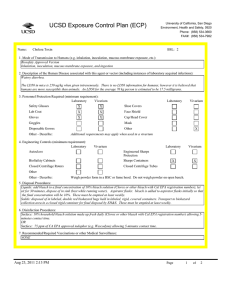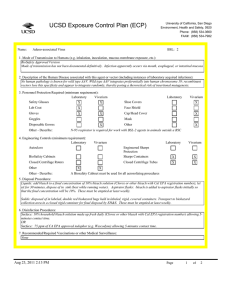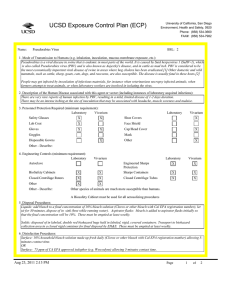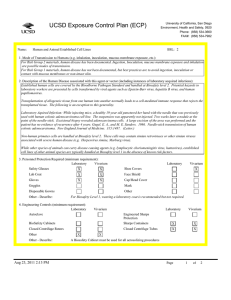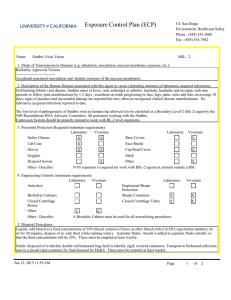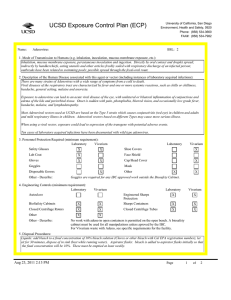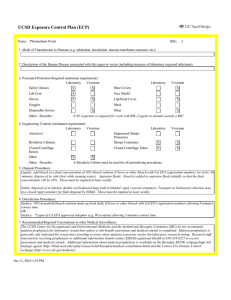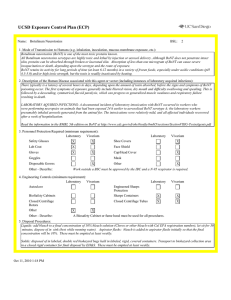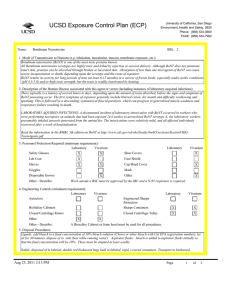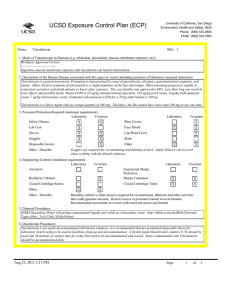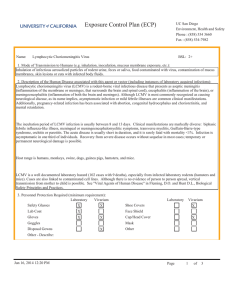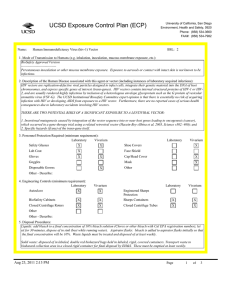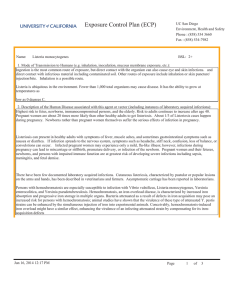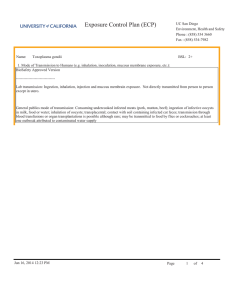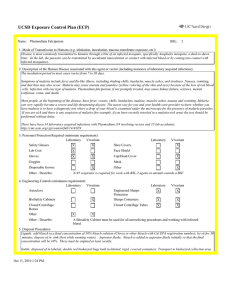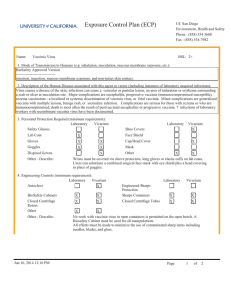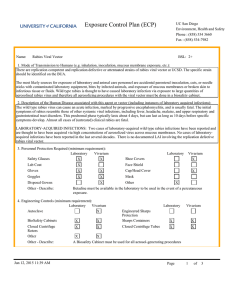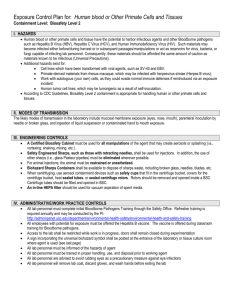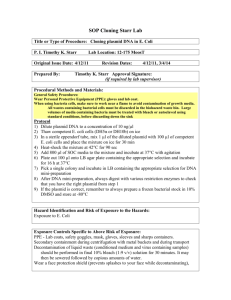UCSD Exposure Control Plan (ECP)
advertisement
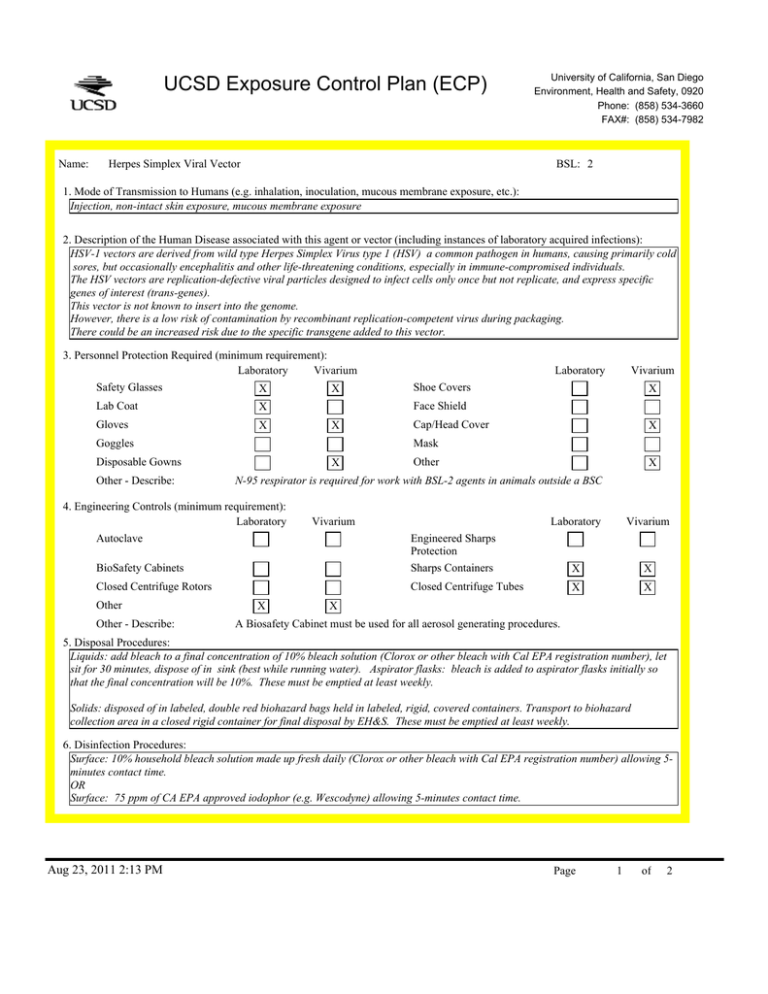
UCSD Exposure Control Plan (ECP) Name: Herpes Simplex Viral Vector University of California, San Diego Environment, Health and Safety, 0920 Phone: (858) 534-3660 FAX#: (858) 534-7982 BSL: 2 1. Mode of Transmission to Humans (e.g. inhalation, inoculation, mucous membrane exposure, etc.): Injection, non-intact skin exposure, mucous membrane exposure 2. Description of the Human Disease associated with this agent or vector (including instances of laboratory acquired infections): HSV-1 vectors are derived from wild type Herpes Simplex Virus type 1 (HSV) a common pathogen in humans, causing primarily cold sores, but occasionally encephalitis and other life-threatening conditions, especially in immune-compromised individuals. The HSV vectors are replication-defective viral particles designed to infect cells only once but not replicate, and express specific genes of interest (trans-genes). This vector is not known to insert into the genome. However, there is a low risk of contamination by recombinant replication-competent virus during packaging. There could be an increased risk due to the specific transgene added to this vector. 3. Personnel Protection Required (minimum requirement): Laboratory Vivarium Safety Glasses X X Lab Coat X Gloves X Vivarium X Face Shield X Goggles Cap/Head Cover X Mask Disposable Gowns Other - Describe: Laboratory Shoe Covers X Other X N-95 respirator is required for work with BSL-2 agents in animals outside a BSC 4. Engineering Controls (minimum requirement): Laboratory Autoclave Laboratory Vivarium BioSafety Cabinets Engineered Sharps Protection Sharps Containers X X Closed Centrifuge Rotors Closed Centrifuge Tubes X X Other Other - Describe: X Vivarium X A Biosafety Cabinet must be used for all aerosol generating procedures. 5. Disposal Procedures: Liquids: add bleach to a final concentration of 10% bleach solution (Clorox or other bleach with Cal EPA registration number), let sit for 30 minutes, dispose of in sink (best while running water). Aspirator flasks: bleach is added to aspirator flasks initially so that the final concentration will be 10%. These must be emptied at least weekly. Solids: disposed of in labeled, double red biohazard bags held in labeled, rigid, covered containers. Transport to biohazard collection area in a closed rigid container for final disposal by EH&S. These must be emptied at least weekly. 6. Disinfection Procedures: Surface: 10% household bleach solution made up fresh daily (Clorox or other bleach with Cal EPA registration number) allowing 5minutes contact time. OR Surface: 75 ppm of CA EPA approved iodophor (e.g. Wescodyne) allowing 5-minutes contact time. Aug 23, 2011 2:13 PM Page 1 of 2 UCSD Exposure Control Plan (ECP) 7. Recommended/Required Vaccinations or other Medical Surveillance: None 8. Employee Exposures- first aid procedures: a. Eye exposure from splash or aerosols - rinse a minimum of 15 minutes in eye wash or flush area with water. b. Skin exposure - wash area with soap and water for 15 minutes c. Needle stick and/or sharps exposure - wash wound area with soap and water for 15 minutes d. Contamination of clothing - remove the contaminated clothing and place in biohazard bag, shower with the emergency douse shower, and put on clean clothes. e. Spill or release - Monday through Friday, 8a - 4:30p call EH&S at (858-5343660); after hours call UCSD Police (858-534-4357) 9. Employee Exposure - seek medical follow-up from the following medical providers: (TAKE THIS ECP WITH YOU) 24-hour walk-in service: Thornton Hospital Emergency Room (858) 657-7600 UCSD Medical Center (Hillcrest) Emergency Room (619) 543-6400 Call the Center for Occupational & Environmental Medicine (COEM) at (619) 471-9210 to determine if a follow up visit with COEM is required. Most exposures will require a visit to COEM. Monday - Friday, 8a - 4:30p Prophylactic treatment with Acyclovir should be considered. 10. Report All Injuries, Illnesses, and Exposures to EH&S: Complete the information found on "What to Do if a Work-Related Injury or Illness Occurs" (http://blink.ucsd.edu/Blink/External/ Topics/How_To/0,1260,4295,00.html) 11. Required Biosafety Training: 1) EH&S Viral Vector biosafety training is required. 2) Laboratory specific training on hazards, exposure evaluations, and the required precautions for experimental procedures used with this agent - provided by Principal Investigator 12. Lab specific instructions: Procedure listed in protocol S02174R. Biohazard sign required, cage card lists hazardous agent, protective equipment (latex gloves, mask (N95), disposable lab coat, goggles, hair net, footcovers, etc.), use of biological safety cabinet, and proper disposal of contaminated tools and equipment used. Aug 23, 2011 2:13 PM Page 2 of 2
